FT-Raman Methodology Applied to Study the Effect of Time and Type of Seasoning in the Crafting of Sherry Casks® Used in the Aging of Brandy De Jerez
Abstract
:1. Introduction
2. Materials and Methods
2.1. Samples
2.2. Chemicals and Reagents
2.3. Chemical Analysis
2.4. FT-Raman Spectra Acquisition
2.5. Chemometric Analysis
3. Results
3.1. Analytical Characterization of the Brandies de Jerez
3.2. The FT-Raman Spectra of the Brandies de Jerez
3.3. The Partial Least Squares Regression Model
4. Conclusions
Author Contributions
Funding
Institutional Review Board Statement
Informed Consent Statement
Data Availability Statement
Acknowledgments
Conflicts of Interest
References
- Consejería de Agricultura Pesca y Desarrollo Rural. Orden de 28 de Junio de 2018, por la que se Aprueba el Expediente Técnico de Indicación Geográfica «Brandy de Jerez»; Boletín Oficial de la Junta de Andalucía: Seville, Spain, 2018; pp. 19–20. [Google Scholar]
- The European Parliament and the Council of the European Union Regulation (EU) 2019/787 On the Definition, Description, Presentation and Labelling of Spirit Drinks, the Use of the Names of Spirit Drinks in the Presentation and Labelling of Other Foodstuffs, the Protection of Geographical Indications for Spirit Drinks, the Use of Ethyl Alcohol and Distillates of Agricultural Origin in Alcoholic Beverages, and Repealing Regulation (EC) No 110/2008; European Union, 2019; p. L130/1-L130/54. Available online: https://eur-lex.europa.eu/legal-content/EN/TXT/?uri=CELEX%3A32019R0787 (accessed on 28 October 2023).
- Valcárcel-Muñoz, M.J.; Guerrero-Chanivet, M.; García-Moreno, M.V.; Rodríguez-Dodero, M.C.; Guillén-Sánchez, D.A. Comparative Evaluation of Brandy de Jerez Aged in American Oak Barrels with Different Times of Use. Foods 2021, 10, 288. [Google Scholar] [CrossRef] [PubMed]
- Regulatory Council Envinado (Wine-Seasoning) Technical Specifications. Available online: https://www.sherry.wine/documents/87/especificacion_tecnica_de_envinado_rev_03.pdf (accessed on 8 August 2023).
- Valcárcel-Muñoz, M.J.; Guerrero-Chanivet, M.; Rodríguez-Dodero, M.C.; García-Moreno, M.V.; Guillén-Sánchez, D.A. Analytical, Chemometric and Sensorial Characterization of Oloroso and Palo Cortado Sherries during Their Ageing in the Criaderas y Solera System. Foods 2022, 11, 4062. [Google Scholar] [CrossRef] [PubMed]
- Valcárcel-Muñoz, M.J.; Guerrero-Chanivet, M.; Rodríguez-Dodero, M.C.; García-Moreno, M.V.; Guillén-Sánchez, D.A. Analytical and Chemometric Characterization of Fino and Amontillado Sherries during Aging in Criaderas y Solera System. Molecules 2022, 27, 365. [Google Scholar] [CrossRef]
- Valcárcel-Muñoz, M.J.; Guerrero-Chanivet, M.; Rodríguez-Dodero, M.C.; Butrón-Benítez, D.; García-Moreno, M.V.; Guillén-Sánchez, D.A. Analytical and Chemometric Characterization of Sweet Pedro Ximénez Sherry Wine during Its Aging in a Criaderas y Solera System. Foods 2023, 12, 1911. [Google Scholar] [CrossRef]
- Anjos, O.; Caldeira, I.; Fernandes, T.A.; Pedro, S.I.; Vitória, C.; Oliveira-Alves, S.; Catarino, S.; Canas, S. PLS-R Calibration Models for Wine Spirit Volatile Phenols Prediction by near-Infrared Spectroscopy. Sensors 2022, 22, 286. [Google Scholar] [CrossRef]
- Van Wyngaard, E.; Blancquaert, E.; Nieuwoudt, H.; Aleixandre-Tudo, J.L. Infrared Spectroscopy Investigation of Fresh Grapevine (Vitis Vinifera) Shoots, Leaves, and Berries Using Novel Chemometric Applications for Viticultural Data. Comput. Electron. Agric. 2022, 203, 107481. [Google Scholar] [CrossRef]
- Radu, A.I.; Kuellmer, M.; Giese, B.; Huebner, U.; Weber, K.; Cialla-May, D.; Popp, J. Surface-Enhanced Raman Spectroscopy (SERS) in Food Analytics: Detection of Vitamins B2 and B12 in Cereals. Talanta 2016, 160, 289–297. [Google Scholar] [CrossRef]
- Sim, S.F.; Ting, W. An Automated Approach for Analysis of Fourier Transform Infrared (FTIR) Spectra of Edible Oils. Talanta 2012, 88, 537–543. [Google Scholar] [CrossRef]
- Pontes, M.J.C.; Santos, S.R.B.; Araújo, M.C.U.; Almeida, L.F.; Lima, R.A.C.; Gaião, E.N.; Souto, U.T.C.P. Classification of Distilled Alcoholic Beverages and Verification of Adulteration by near Infrared Spectrometry. Food Res. Int. 2006, 39, 182–189. [Google Scholar] [CrossRef]
- Mandrile, L.; Zeppa, G.; Giovannozzi, A.M.; Rossi, A.M. Controlling Protected Designation of Origin of Wine by Raman Spectroscopy. Food Chem. 2016, 211, 260–267. [Google Scholar] [CrossRef]
- Song, L.M.; Liu, L.W.; Yang, Y.G.; Xi, J.T.; Guo, Q.H.; Zhu, X.J. Online Detection of Distilled Spirit Quality Based on Laser Raman Spectroscopy. J. Inst. Brew. 2017, 123, 121–129. [Google Scholar] [CrossRef]
- Frausto-Reyes, C.; Medina-Gutiérrez, C.; Sato-Berrú, R.; Sahagún, L.R. Qualitative Study of Ethanol Content in Tequilas by Raman Spectroscopy and Principal Component Analysis. Spectrochim. Acta A Mol. Biomol. Spectrosc. 2005, 61, 2657–2662. [Google Scholar] [CrossRef] [PubMed]
- Anjos, O.; Santos, R.; Estevinho, L.M.; Caldeira, I. FT-Raman Methodology for the Monitoring of Honeys’ Spirit Distillation Process. Food Chem. 2020, 305, 125511. [Google Scholar] [CrossRef] [PubMed]
- Espinosa-Vega, L.I.; Belio-Manzano, A.; Mercado-Ornelas, C.A.; Cortes-Mestizo, I.E.; Mendez-Garcia, V.H. Aging Spectral Markers of Tequila Observed by Raman Spectroscopy. Eur. Food Res. Technol. 2019, 245, 1031–1036. [Google Scholar] [CrossRef]
- Berghian-Grosan, C.; Magdas, D.A. Application of Raman Spectroscopy and Machine Learning Algorithms for Fruit Distillates Discrimination. Sci. Rep. 2020, 10, 21152. [Google Scholar] [CrossRef]
- Anjos, O.; Caldeira, I.; Pedro, S.I.; Canas, S. FT-Raman Methodology Applied to Identify Different Ageing Stages of Wine Spirits. LWT 2020, 134, 110179. [Google Scholar] [CrossRef]
- Edelmann, A.; Diewok, J.; Schuster, K.C.; Lendl, B. Rapid Method for the Discrimination of Red Wine Cultivars Based on Mid-Infrared Spectroscopy of Phenolic Wine Extracts. J. Agric. Food Chem. 2001, 49, 1139–1145. [Google Scholar] [CrossRef]
- Mendes, L.S.; Oliveira, F.C.C.; Suarez, P.A.Z.; Rubim, J.C. Determination of Ethanol in Fuel Ethanol and Beverages by Fourier Transform (FT)-near Infrared and FT-Raman Spectrometries. Anal. Chim. Acta 2003, 493, 219–231. [Google Scholar] [CrossRef]
- Nordon, A.; Mills, A.; Burn, R.T.; Cusick, F.M.; Littlejohn, D. Comparison of Non-Invasive NIR and Raman Spectrometries for Determination of Alcohol Content of Spirits. Anal. Chim. Acta 2005, 548, 148–158. [Google Scholar] [CrossRef]
- Teixeira dos Santos, C.A.; Páscoa, R.N.M.J.; Porto, P.A.L.S.; Cerdeira, A.L.; González-Sáiz, J.M.; Pizarro, C.; Lopes, J.A. Raman Spectroscopy for Wine Analyses: A Comparison with near and Mid Infrared Spectroscopy. Talanta 2018, 186, 306–314. [Google Scholar] [CrossRef]
- Valcárcel-Muñoz, M.J.; Butrón-Benítez, D.; Guerrero-Chanivet, M.; García-Moreno, M.V.; Rodríguez-Dodero, M.C.; Guillén-Sánchez, D.A. Influence of Alcoholic Strength on the Characteristics of Brandy de Jerez Aged in Sherry Casks®. J. Food Compos. Anal. 2022, 111, 104618. [Google Scholar] [CrossRef]
- Schwarz, M.; Rodríguez, M.C.; Guillén, D.A.; Barroso, C.G. Development and Validation of UPLC for the Determination of Phenolic Compounds and Furanic Derivatives in Brandy de Jerez. J. Sep. Sci. 2009, 32, 1782–1790. [Google Scholar] [CrossRef] [PubMed]
- Madrera, R.R.; Lobo, A.P.; Alonso, J.J.M. Effect of Cider Maturation on the Chemical and Sensory Characteristics of Fresh Cider Spirits. Food Res. Int. 2010, 43, 70–78. [Google Scholar] [CrossRef]
- Ruiz, H.A.; Thomsen, M.H.; Trajano, H.L. Hydrothermal Processing in Biorefineries: Production of Bioethanol and High Added-Value Compounds of Second and Third Generation Biomass; Springer: Berlin/Heidelberg, Germany, 2017; ISBN 9783319564579. [Google Scholar]
- Moreno, J.A.; Zea, L.; Moyano, L.; Medina, M. Aroma Compounds as Markers of the Changes in Sherry Wines Subjected to Biological Ageing. Food Control 2005, 16, 333–338. [Google Scholar] [CrossRef]
- Silva, M.L.; Malcata, F.X.; Silva, M.L.; Malcata, F.X. Effects of Time of Grape Pomace Fermentation and Distillation Cuts on the Chemical Composition of Grape Marcs. Z. Leb. Unters. Forsch. A 1999, 208, 134–143. [Google Scholar] [CrossRef]
- Hernández-Gómez, L.F.; Úbeda, J.; Briones, A. Melon Fruit Distillates: Comparison of Different Distillation Methods. Food Chem. 2003, 82, 539–543. [Google Scholar] [CrossRef]
- García-Llobodanin, L.; Achaerandio, I.; Ferrando, M.; Güell, C.; López, F. Pear Distillates from Pear Juice Concentrate: Effect of Lees in the Aromatic Composition. J. Agric. Food Chem. 2007, 55, 3462–3468. [Google Scholar] [CrossRef]
- Alonso, Á.M.; Castro, R.; Rodríguez, M.C.; Guillén, D.A.; Barroso, C.G. Study of the Antioxidant Power of Brandies and Vinegars Derived from Sherry Wines and Correlation with Their Content in Polyphenols. Food Res. Int. 2004, 37, 715–721. [Google Scholar] [CrossRef]
- Roullier-Gall, C.; Signoret, J.; Hemmler, D.; Witting, M.A.; Kanawati, B.; Schäfer, B.; Gougeon, R.D.; Schmitt-Kopplin, P. Usage of FT-ICR-MS Metabolomics for Characterizing the Chemical Signatures of Barrel-Aged Whisky. Front. Chem. 2018, 6, 29. [Google Scholar] [CrossRef]
- Stupak, M.; Goodall, I.; Tomaniova, M.; Pulkrabova, J.; Hajslova, J. A Novel Approach to Assess the Quality and Authenticity of Scotch Whisky Based on Gas Chromatography Coupled to High Resolution Mass Spectrometry. Anal. Chim. Acta 2018, 1042, 60–70. [Google Scholar] [CrossRef]
- González-Gordon, M.M. Jerez, Xerez, Sherish, 1st ed.; Libros Ambigú: Madrid, Spain, 2005. [Google Scholar]
- Barquín, J.; Liem, P. Jerez, Manzanilla y Montilla: Vinos Tradicionales de Andalucía; Abalon Books: Barcelona, Spain, 2019. [Google Scholar]
- Picard, A.; Daniel, I.; Montagnac, G.; Oger, P. In Situ Monitoring by Quantitative Raman Spectroscopy of Alcoholic Fermentation by Saccharomyces Cerevisiae under High Pressure. Extremophiles 2007, 11, 445–452. [Google Scholar] [CrossRef] [PubMed]
- Vaskova, H. Spectroscopic Determination of Methanol Content in Alcoholic Drinks. Int. J. Biol. Biomed. Eng. 2014, 8, 27–34. [Google Scholar]
- Coussan, S.; Alikhani, M.E.; Perchard, J.P.; Zheng, W.Q. Infrared-Induced Isomerization of Ethanol Dimers Trapped in Argon and Nitrogen Matrices: Monochromatic Irradiation Experiments and DFT Calculations. J. Phys. Chem. A 2000, 104, 5475–5483. [Google Scholar] [CrossRef]
- Korolevich, M.V.; Zhbankov, R.G.; Sivchik, V.V. Calculation of Absorption Band Frecquencies and Intensities in the IR Spectrum of A-D-Glucose in a Cluster. J. Mol. Struct. 1990, 220, 301–313. [Google Scholar] [CrossRef]
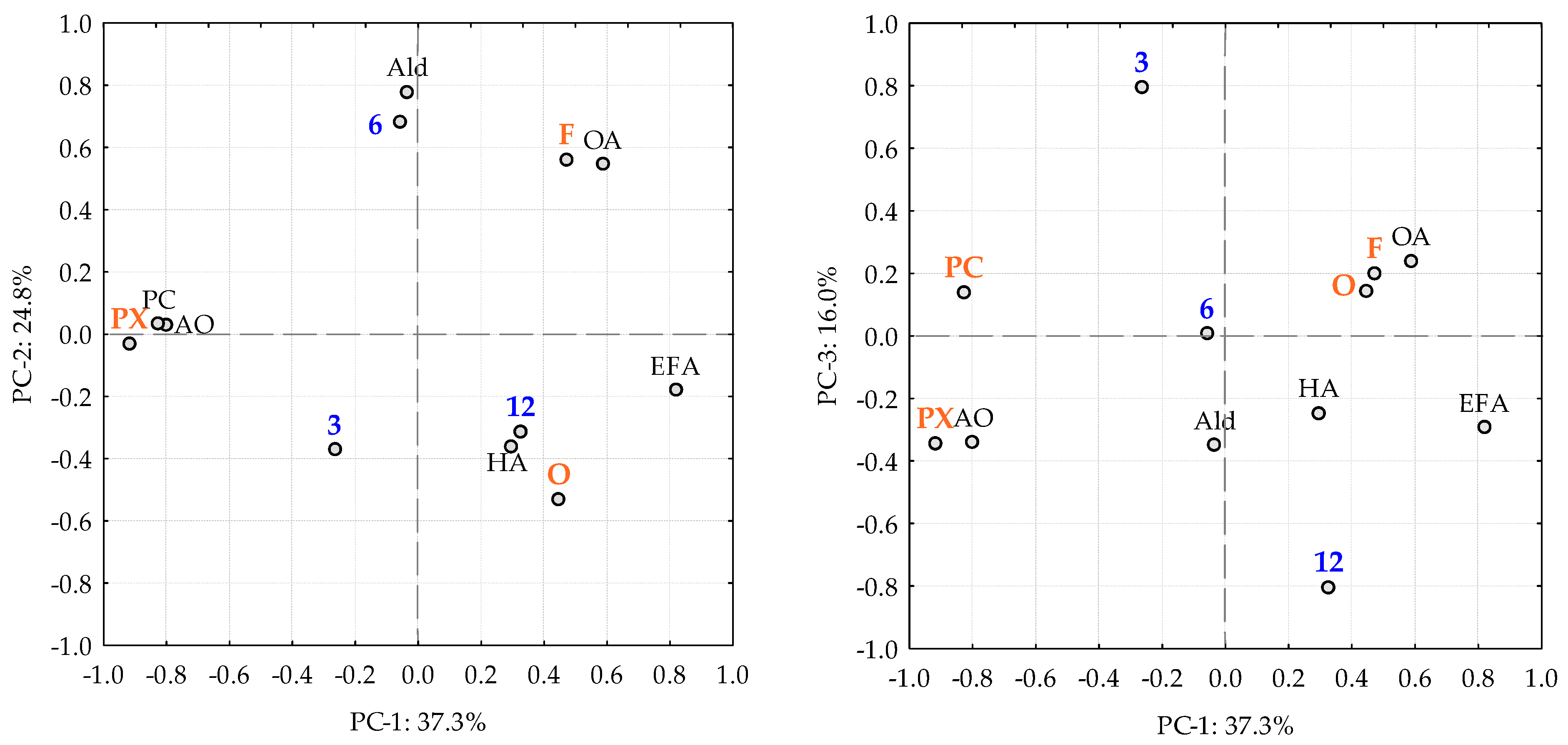


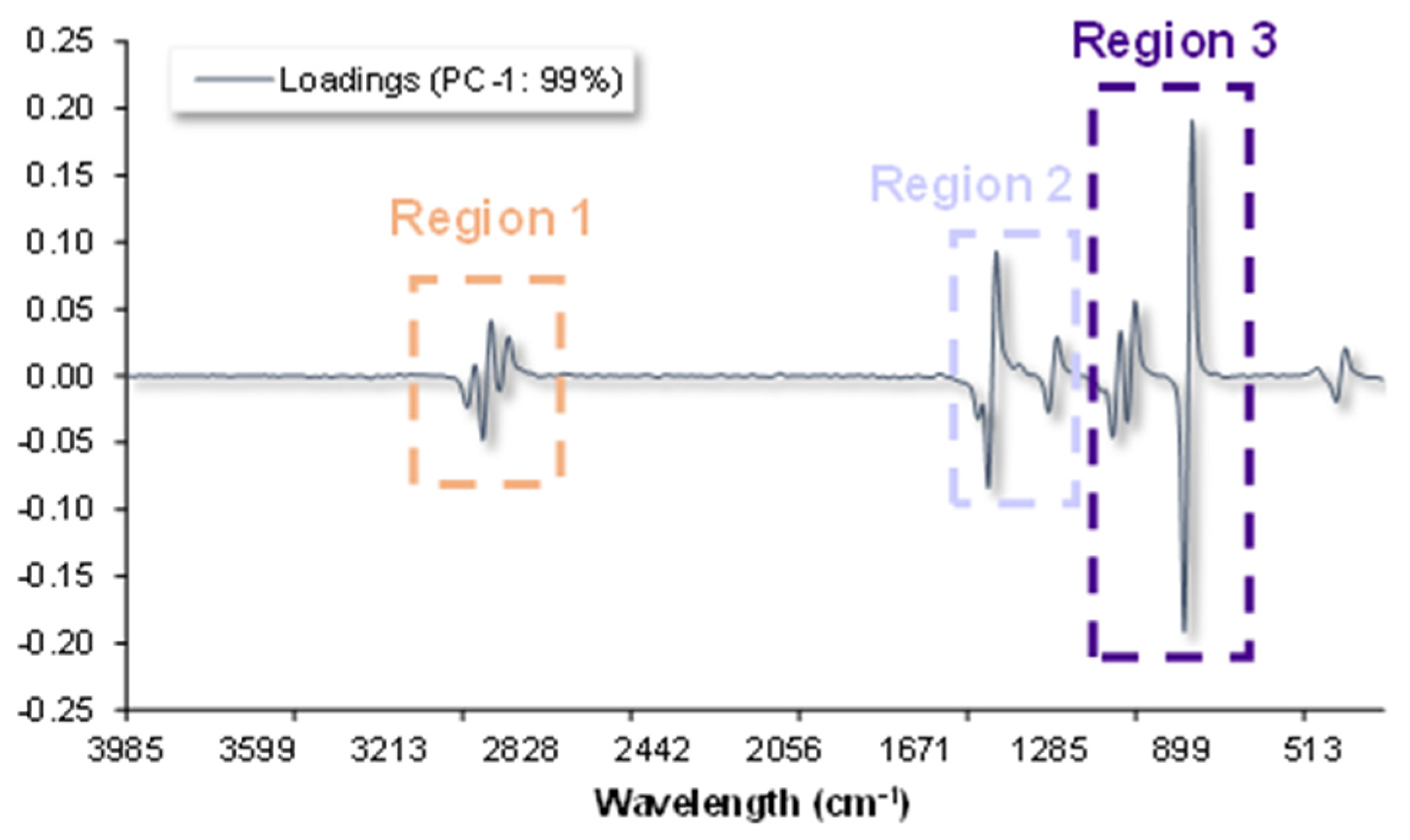
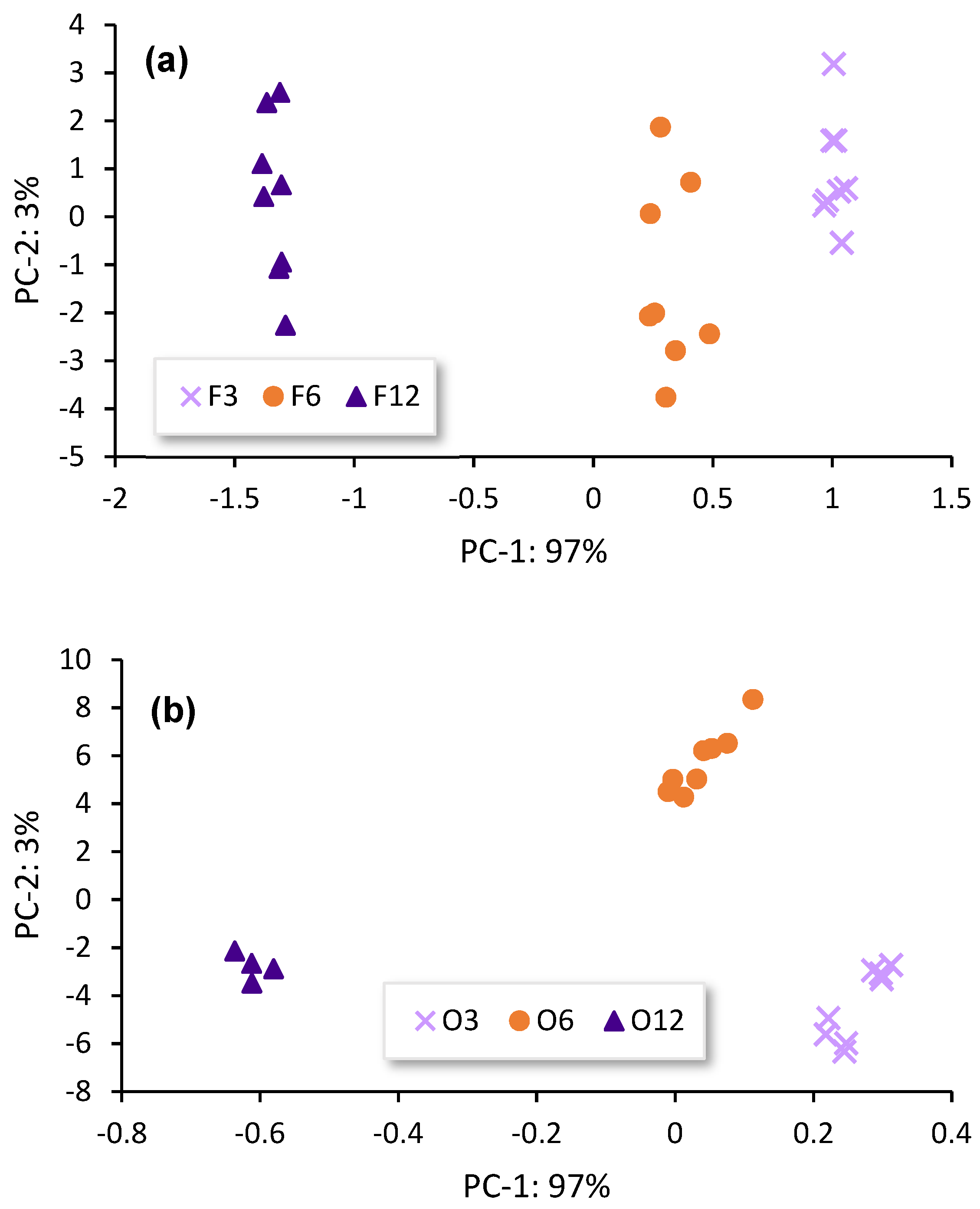
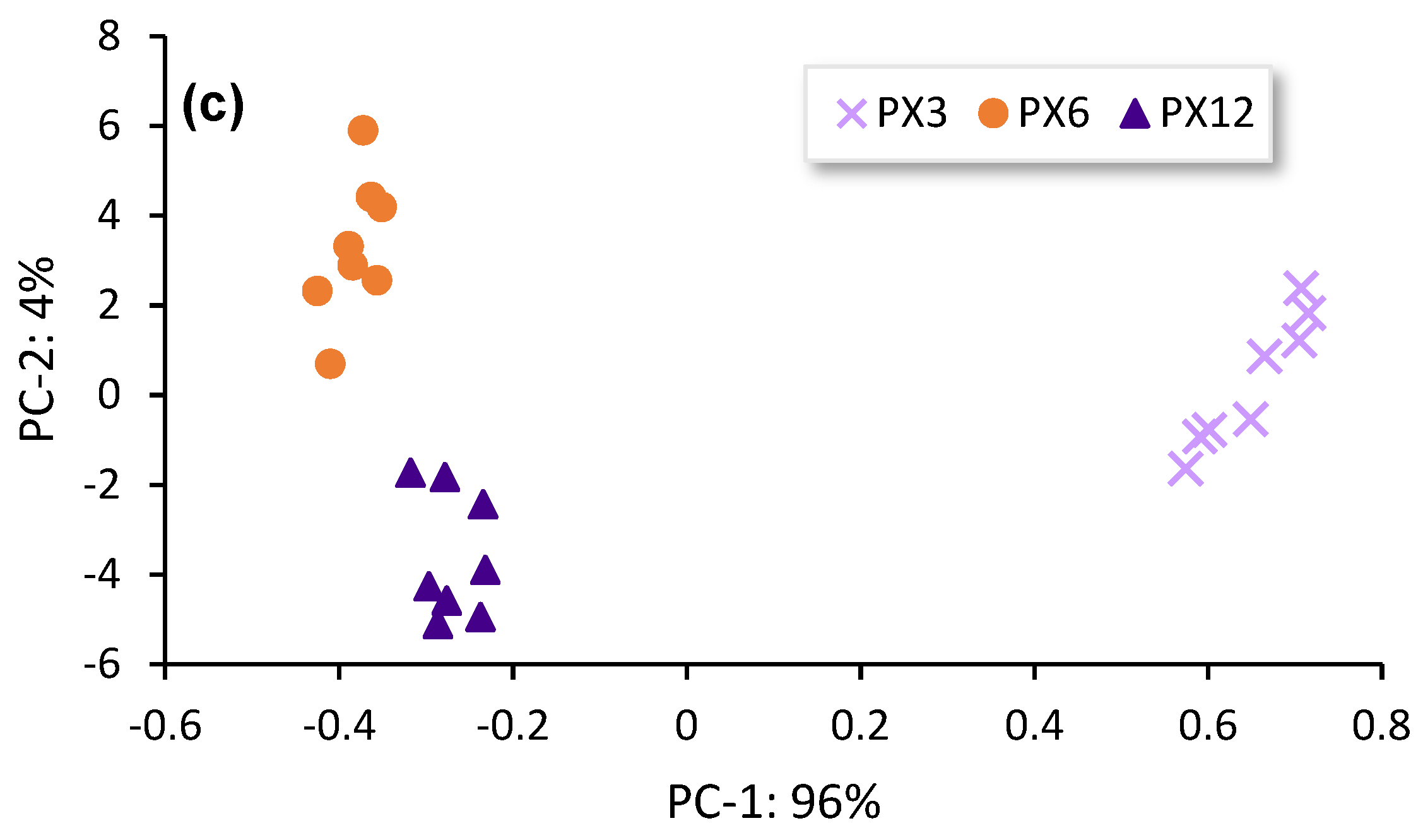
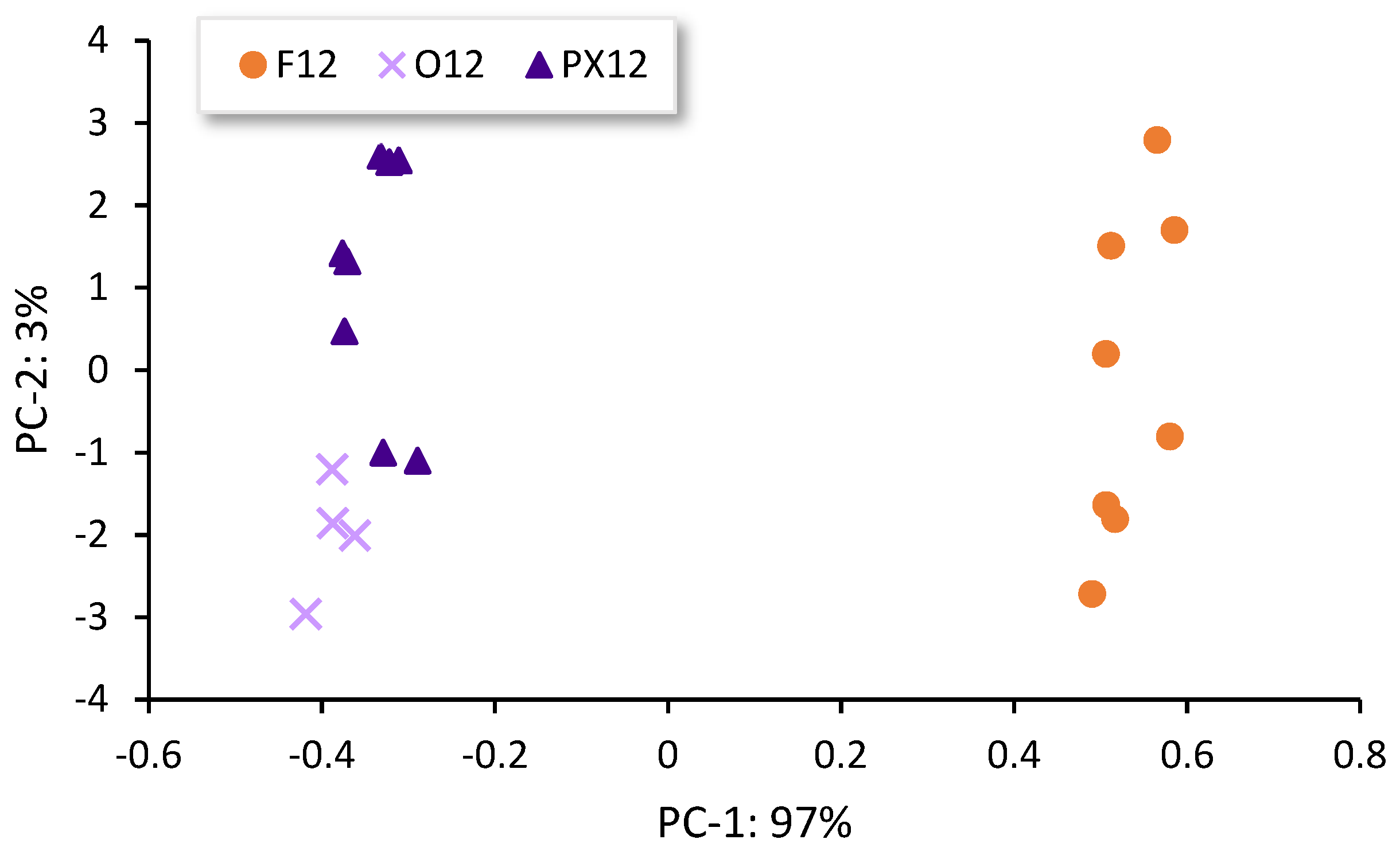
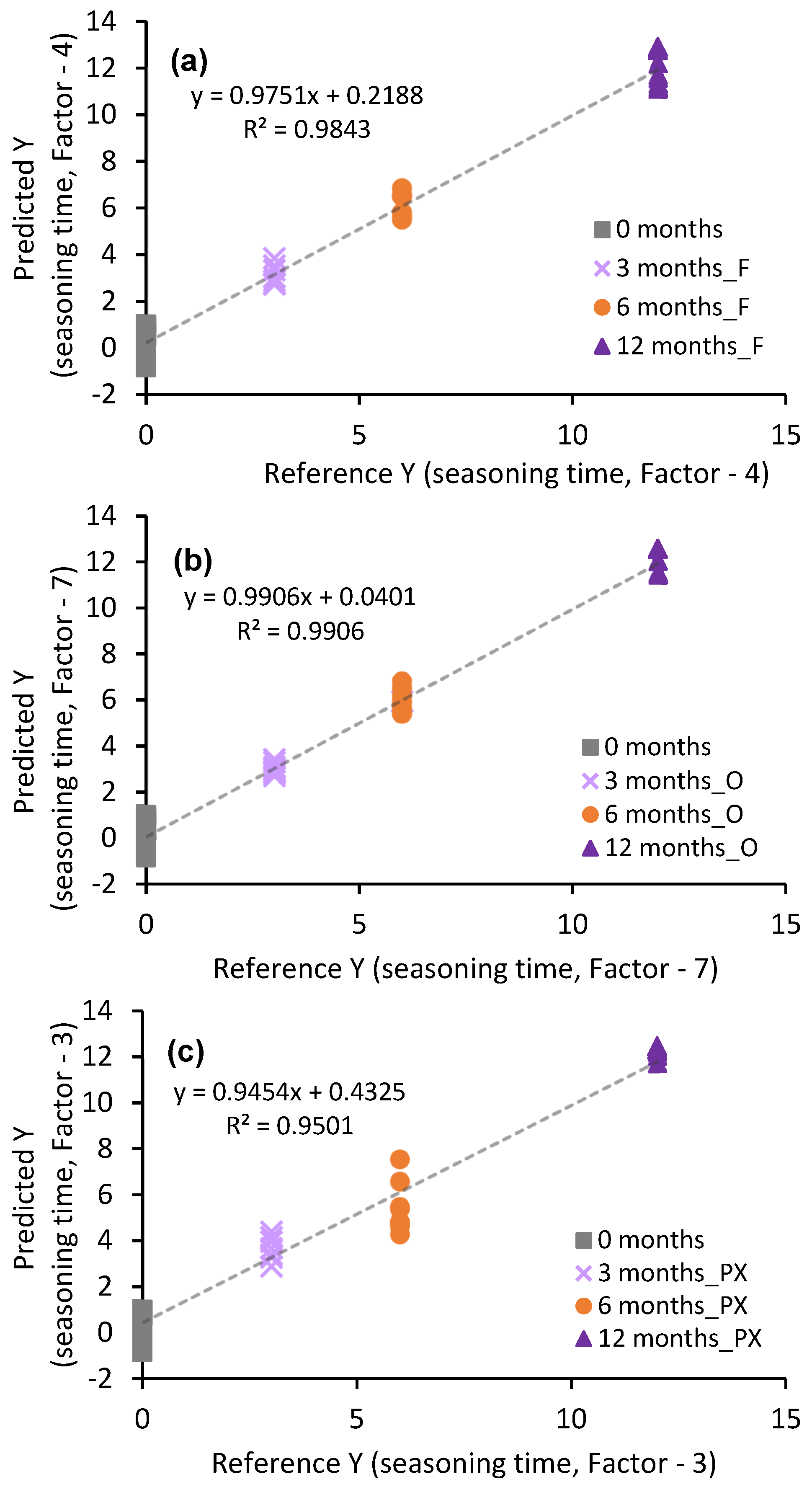
| Experience | Sherry Wine | Seasoning Time (Months) | Ageing Time (Months) |
|---|---|---|---|
| 0 months | None | 0 | 12 |
| 3 months | F, O, PX | 3 | 12 |
| 6 months | F, O, PX | 6 | 12 |
| 12 months | F, O, PX | 12 | 12 |
| Samples | Organic Acids (mg/L) | Aldehydes (mg/L) | Higher Alcohols (mg/L) | Esters from Fatty Acids (mg/L) | Esters from Organic Acids (mg/L) | Phenolic and Furanic Compounds (mg/L) |
|---|---|---|---|---|---|---|
| Fino Sherry Casks® | ||||||
| C0 | 380.92 ± 21.24 c | 126.97 ± 2.08 a | 2039.28 ± 14.45 | 20.06 ± 0.15 a | 342.23 ± 7.39 b | 105.28 ± 25.44 b |
| F3 | 200.71 ± 9.96 a | 139.74 ± 8.23 b | 2032.16 ± 55.17 | 25.73 ± 0.16 b | 308.51 ± 18.32 a | 38.73 ± 13.12 a |
| F6 | 216.21 ± 28.61 ab | 147.53 ± 9.56 c | 2025.89 ± 18.53 | 26.22 ± 0.75 c | 311.94 ± 17.99 a | 39.10 ± 20.64 a |
| F12 | 225.24 ± 1.93 b | 149.51 ± 4.75 c | 2054.50 ± 2.54 | 29.23 ± 0.23 d | 306.99 ± 11.11 a | 26.93 ± 6.58 a |
| Oloroso Sherry Casks® | ||||||
| C0 | 380.92 ± 21.24 b | 126.97 ± 2.08 a | 2039.28 ± 14.45 ab | 20.06 ± 0.15 a | 342.23 ± 7.39 c | 105.28 ± 25.44 a |
| O3 | 213.50 ± 35.85 a | 124.12 ± 14.21 a | 2044.19 ± 1.77 ab | 26.27 ± 1.30 b | 281.12 ± 2.82 a | 48.41 ± 13.35 ab |
| O6 | 204.66 ± 31.64 a | 143.11 ± 11.70 b | 2031.24 ± 7.94 a | 29.73 ± 0.29 c | 305.12 ± 20.14 b | 45.85 ± 12.84 b |
| O12 | 216.99 ± 16.05 a | 137.05 ± 2.67 b | 2051.92 ± 20.07 b | 30.14 ± 0.84 c | 291.33 ± 5.00 a | 30.18 ± 16.01 c |
| Pedro Ximénez Sherry Casks® | ||||||
| C0 | 380.92 ± 21.24 c | 126.97 ± 2.08 a | 2039.28 ± 14.45 ab | 20.06 ± 0.15 a | 342.23 ± 7.39 c | 105.28 ± 25.44 c |
| PX3 | 271.22 ± 3.40 b | 138.46 ± 9.43 b | 2028.32 ± 54.99 ab | 23.49 ± 0.20 b | 273.07 ± 15.14 b | 76.49 ± 3.67 b |
| PX6 | 271.94 ± 5.17 b | 154.58 ± 1.69 c | 2012.87 ± 23.37 a | 23.47 ± 0.16 b | 276.73 ± 4.03 b | 68.28 ± 6.09 b |
| PX12 | 254.17 ± 5.18 a | 138.32 ± 4.87 b | 2045.91 ± 18.62 b | 26.05 ± 0.23 c | 262.72 ± 5.08 a | 48.28 ± 1.23 a |
| Wavelength (cm−1) | Interpretation |
|---|---|
| 3000–3500 | –OH stretching [21] |
| 2700–3000 | –H and –OH stretching modes (ethanol, methanol, hydrocarbons, and other organic molecules) [37,38] |
| 1480–1450 | –CH2, –CH3 bending (also influenced by ethanol content in the samples) and H-C-H bending modes [21,39] |
| 1278 | H-C-C stretching [39] |
| 1091–1050 | C-O stretching vibration (associated with the presence of ethanol and methanol content), CH3 rocking vibrations and C-C stretching [37] |
| 882 | C-C stretching vibration (is the most characteristic band of ethanol) [38] |
| 430–490 | O-C-C bending [40] |
| Model | % Variance Explain | |
|---|---|---|
| in PC-1 | in PC-2 (%) | |
| Fino (F) | 97 | 3 |
| Oloroso (O) | 97 | 3 |
| Pedro Ximénez (PX) | 96 | 4 |
| Fino (F) | Oloroso (O) | Pedro Ximénez (PX) | ||||
|---|---|---|---|---|---|---|
| Statistic of regression equation | ||||||
| R2 (Pearson) | 0.9751 | 0.9906 | 0.9454 | |||
| RMSEC | 0.6483 | 0.3754 | 1.1224 | |||
| RMSEP | 1.8593 | 0.3755 | 2.1751 | |||
| Statistic of slope and offset | ||||||
| Slope | Offset | Slope | Offset | Slope | Offset | |
| Value | 0.9751 | 0.2188 | 0.9906 | 0.0401 | 0.9454 | 0.4325 |
| Standard deviation | 0.0264 | 0.1814 | 0.0189 | 0.1092 | 0.0447 | 0.3071 |
| p value | 0.423 | 0.541 | 0.624 | 0.716 | 0.162 | 0.282 |
| % p | 57.7 | 45.9 | 37.6 | 28.4 | 83.8 | 71.8 |
| t (0.05,32-2) | 0.812 | 0.618 | 0.496 | 0.368 | 1.434 | 1.096 |
| Lower limit (95%) | 0.9572 | −0.0001 | 0.9813 | −0.0001 | 0.8719 | −0.0005 |
| Upper limit (95%) | 1.0001 | 0.2243 | 1.00001 | 0.0803 | 1.0001 | 0.6724 |
| ST | ST Predicted | STD Error | |
|---|---|---|---|
| Brandy de Jerez aged in Fino Sherry Casks® | |||
| C0 | 0 | 0.139 | 0.702 |
| F3 | 3 | 3.240 | 0.690 |
| F6 | 6 | 6.143 | 0.688 |
| F12 | 12 | 11.853 | 0.711 |
| Brandy de Jerez aged in Oloroso Sherry Casks® | |||
| C0 | 0 | 0.027 | 0.407 |
| O3 | 3 | 3.028 | 0.399 |
| O6 | 6 | 5.986 | 0.400 |
| O12 | 12 | 11.918 | 0.425 |
| Brandy de Jerez aged in Pedro Ximénez Sherry Casks® | |||
| C0 | 0 | 0.483 | 1.242 |
| PX3 | 3 | 3.786 | 1.222 |
| PX6 | 6 | 5.445 | 1.218 |
| PX12 | 12 | 11.786 | 1.263 |
Disclaimer/Publisher’s Note: The statements, opinions and data contained in all publications are solely those of the individual author(s) and contributor(s) and not of MDPI and/or the editor(s). MDPI and/or the editor(s) disclaim responsibility for any injury to people or property resulting from any ideas, methods, instructions or products referred to in the content. |
© 2023 by the authors. Licensee MDPI, Basel, Switzerland. This article is an open access article distributed under the terms and conditions of the Creative Commons Attribution (CC BY) license (https://creativecommons.org/licenses/by/4.0/).
Share and Cite
Guerrero-Chanivet, M.; Guillén-Sánchez, D.A.; Valcárcel-Muñoz, M.J.; García-Moreno, M.V.; Anjos, O. FT-Raman Methodology Applied to Study the Effect of Time and Type of Seasoning in the Crafting of Sherry Casks® Used in the Aging of Brandy De Jerez. Sensors 2023, 23, 8962. https://doi.org/10.3390/s23218962
Guerrero-Chanivet M, Guillén-Sánchez DA, Valcárcel-Muñoz MJ, García-Moreno MV, Anjos O. FT-Raman Methodology Applied to Study the Effect of Time and Type of Seasoning in the Crafting of Sherry Casks® Used in the Aging of Brandy De Jerez. Sensors. 2023; 23(21):8962. https://doi.org/10.3390/s23218962
Chicago/Turabian StyleGuerrero-Chanivet, María, Dominico A. Guillén-Sánchez, Manuel José Valcárcel-Muñoz, M. Valme García-Moreno, and Ofelia Anjos. 2023. "FT-Raman Methodology Applied to Study the Effect of Time and Type of Seasoning in the Crafting of Sherry Casks® Used in the Aging of Brandy De Jerez" Sensors 23, no. 21: 8962. https://doi.org/10.3390/s23218962
APA StyleGuerrero-Chanivet, M., Guillén-Sánchez, D. A., Valcárcel-Muñoz, M. J., García-Moreno, M. V., & Anjos, O. (2023). FT-Raman Methodology Applied to Study the Effect of Time and Type of Seasoning in the Crafting of Sherry Casks® Used in the Aging of Brandy De Jerez. Sensors, 23(21), 8962. https://doi.org/10.3390/s23218962









